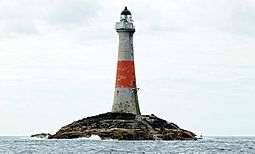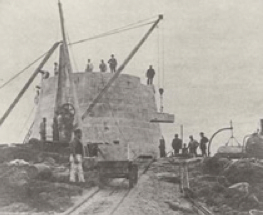Dubh Artach facts for kids
| Gaelic name | Dubh Artach |
|---|---|
| Meaning of name | The Black Rock |
 Dubh Artach skerry and lighthouse in 2014 |
|
| OS grid reference | NM119030 |
| Coordinates | 56°08′N 6°38′W / 56.13°N 6.63°W |
| Physical geography | |
| Island group | Isle of Mull |
| Area | c.32,300 square feet (3,000 m2) |
| Highest elevation | 36 feet (11 m) |
| Administration | |
| Sovereign state | United Kingdom |
| Country | Scotland |
| Council area | Argyll and Bute |
| Demographics | |
| Population | 0 |
Dubh Artach is a lonely, rocky island called a skerry. It's made of basalt rock and sits far out in the sea off the west coast of Scotland. It's about 18 miles (29 km) west of Colonsay and 15 miles (24 km) south-west of the Ross of Mull.
A tall lighthouse was built here between 1867 and 1872. It was designed by Thomas Stevenson, whose son was the famous writer Robert Louis Stevenson. The lighthouse tower is 145 feet (44 m) tall. The sea around Dubh Artach can be incredibly rough, with waves sometimes reaching 92 feet (28 m) or more! Despite these tough conditions, some lighthouse keepers worked there for many years until the light became automatic in 1971. The official name of the lighthouse is Dubh Artach. The rock itself is also sometimes called Dhu Heartach. The name Dubh Artach comes from an old Gaelic word, and it most likely means "The Black Rock".
Contents
What is Dubh Artach made of?
Long, long ago, in pre-historic times, huge sheets of ice covered Scotland and stretched far out into the Atlantic Ocean. After the ice melted about 20,000 years ago, sea levels were much lower. It's thought that Dubh Artach was once part of a big land bridge. This bridge might have connected what is now Ireland to Scotland.
As sea levels slowly rose, Dubh Artach became isolated. Today, it's a rounded, dark green rock made of basalt. It's about 240 feet (73 m) long and 130 feet (40 m) wide. It rises about 35 feet (11 m) above the sea. Underwater surveys show that the rock is at the end of a long valley stretching 80 miles (130 km) into the Atlantic. This might explain why the seas around it are so wild.
The famous author Robert Louis Stevenson once wrote about this rock:
An ugly reef is this of the Dhu Heartach; no pleasant assemblage of shelves, and pools, and creeks, about which a child might play for a whole summer without weariness, like the Bell Rock or the Skerryvore, but one oval nodule of black-trap, sparsely bedabbled with an inconspicuous fucus, and alive in every crevice with a dingy insect between a slater and a bug. No other life was there but of sea-birds, and of the sea itself, that here ran like a mill-race, and growled about the outer reef for ever, and ever and again, in the calmest weather, roared and spouted on the rock itself.
What does the name mean?
The name Dubh Artach means "The Black Rock". Artach is an old Gaelic word for a rock or rocky ground. You might see it spelled Dhu Heartach sometimes. This happened because of how the Gaelic words sounded when people tried to write them in English.
Stevenson thought the name meant 'black and dismal'. Another old name for the rock was An Dubh Iar-stac, which means "The Black Stack of the West". Some people also think the name might come from an old Irish word meaning "death", suggesting "the black deadly one". Before the lighthouse was built, the skerry was also known as St. John's Rock.
Building the Lighthouse
Between 1800 and 1854, thirty ships crashed on the reef near Dubh Artach. A lighthouse was desperately needed. It would not only warn ships away from Dubh Artach but also guide them past the dangerous Torran Rocks. These rocks lie between the Ross of Mull and Colonsay.
At first, people thought it was impossible to build a lighthouse here. But after a ship called the Bussorah sank in 1863, and 24 more ships were lost in a storm in 1865, something had to be done. Insurance companies like Lloyd's of London pushed for action. The famous Stevenson family of engineers, brothers Thomas and David, started work in 1866. Thomas said it would be "a work of no ordinary magnitude" (a very big and difficult job).

The building work started on 25 June 1867. The engineers used a nearby island called Erraid as their base. Erraid was 14 miles (23 km) away across the open sea. It had a granite quarry for stone and a place for the workers to stay.
One of the first things built on the rock was an iron barrack for the workers. It was 77 feet (23 m) above sea level, but summer storms brought waves that crashed over its roof! Once, fourteen men were trapped inside for five days. Seawater even poured in, washing away their food. Robert Louis Stevenson wrote about how the foreman, Mr. Goodwillie, would play his fiddle to cheer up the men during storms.
Despite these dangers, they dug a 36-foot (11 m) wide foundation pit. By 1869, they had built the solid bottom part of the tower, which was 32 feet (9.8 m) tall. This was a huge achievement! Once, eleven two-ton stones were ripped from the tower and swept away by the sea.
The solid base of the lighthouse weighs 1,840 tons and rises over 64 feet (20 m) above the waves. This is more than twice as high as the base of the Skerryvore lighthouse, another famous Scottish lighthouse. The stone blocks were shaped and fitted together on Erraid. Then, they were towed out to the rock on barges by a steamer called ‘Dhuheartach’. Each barge carried 16 tons of stone.
The stone tower was finished in 1871. The light and fog bell were added the next year. Dubh Artach was the first isolated rock lighthouse in Britain to use paraffin (a type of oil) for its light. The finished tower is 101 feet (31 m) tall from its foundation.
The total cost of building the lighthouse was £65,784. This didn't include the £10,300 spent on the shore station on Erraid. Thomas Stevenson praised the brave men who worked on the lighthouse, saying very few of them gave up, even though it was a very dangerous job.
How the Lighthouse Worked
| Location | Dhu Heartach skerry 18 miles (29 km) west of Colonsay, Argyll, Scotland |
|---|---|
| Tower shape | tapered cylindrical tower with balcony and lantern incorporating keeper's quarter |
Even after the lighthouse was built, it was still a very difficult place to work. At low tide, the landing stage is 40 feet (12 m) above a boat. It was very hard to get on and off the rock, even on calm days. Keepers often had to use ropes dangling from a crane.
The storms were incredibly powerful. In the first year the lighthouse was open, a lightning conductor (a metal rod that protects from lightning) was ripped off the tower by a storm. This happened at a height of 92 feet (28 m) above the high water mark!
The first main keeper was James Ewing, who worked there for eleven years. Despite the very tough conditions, many keepers stayed for a long time. They even received extra payments because of how hard the job was. However, some keepers found the lonely rock and small living spaces too much. One keeper had to be stopped from jumping into the sea and trying to swim to shore!
Later Years of the Lighthouse
- In 1874, the main keeper reported something that felt like an earth tremor. But the strong tower stayed standing.
- Robert Louis Stevenson used his connection to Dubh Artach and its shore station on Erraid in his 1886 novel Kidnapped. In the book, the main character, David Balfour, faces the dangers of the Torran Rocks and gets stranded on Erraid.
- In 1890, a special red band was painted around the middle of the tower. This was to make it look different from Skerryvore lighthouse, which is 20 miles (32 km) to the northwest. Both lighthouses were managed from the same shore station.
- In 1898, some important people, including the head of the Board of Trade and the Chancellor of the Exchequer, visited Dubh Artach. They were discussing how to pay for lighthouses.
- The lighthouse's name was officially changed in 1964 from Dhuheartach to Dubh Artach. This might have been to make it easier for English speakers to spell.
- The lighthouse became fully automatic in 1971. This meant keepers no longer had to live there. The next year, a helipad (a landing spot for helicopters) was built. This made it easier to do maintenance work without dangerous sea landings.



